The most important ingredient in pizza dough is flour. So to make the perfect Neapolitan pizza, you need the right type of flour.
The best all-around flour for classic Neapolitan pizza is Caputo Pizzeria, which is a strong Italian Tipo 00 flour made for a long fermentation and to handle baking at a high temperature.
Do You Really Need Pizza Flour for Neapolitan Pizza?
You don’t absolutely need fancy, Italian imported pizza flour to make great pizza, but if you want the best result, you should choose the best tool for the job. You can probably get a nail into your wall using a screwdriver, but a hammer would make the job easier. The same goes for pizza flour. A high-quality pizza flour makes it easier to make a stretchy dough, that can withstand longer fermentation times and will also create a flavorful pizza crust.
Just the Right Amount of Gluten
To make stretchy pizza dough, you need gluten development. Gluten is a group of proteins found in wheat that forms a network of gluten strands when it absorbs water. Gluten makes the dough elastic and stretchy and allows it to keep its shape during fermentation. To master pizza or any other baking, it’s essential to understand how gluten works – check out this article for more.
For Neapolitan pizza, which often is left to rise for 24 hours, you need a medium-high gluten content. The reason is higher gluten content forms a stronger network that will prevent the dough from collapsing or puncturing (and releasing all the CO2 developed in the fermentation process) during a 24-hour fermentation.
Too much gluten is not good either. If your dough contains too much gluten, the gluten network will get so strong that it gets hard to stretch and shape your dough.
You therefore ideally want to use flour with a gluten content of 11-13%. But adjust it according to the length of the fermentation, For an 8-hour fermentation you want to be closer to 11%, while for a 48-hour fermentation, you want to be closer to 13% gluten.
A Quality Flour Will Give You a Better Flavor
The flour is also what provides most of the flavor of the crust. A good flour will therefore create a more flavorful pizza crust. Part of the reason you let Neapolitan pizza dough rise slowly is to develop a stronger, more complex flavor in the crust. The choice of flour is therefore essential since this is where the flavor mainly comes from. If there’s one ingredient in the dough you shouldn’t skip on, it’s flour. Use quality flour, you’ll thank me later. You’ll be amazed at how much of a difference the type of flour can make!
How to Choose the Right Flour for Pizza
The main factors to consider when you choose pizza flour are fermentation time, hydration, and baking temperature.
Tipo 0 or Tipo 00 Flour
“When in Rome do as the Romans do.” Likewise, when baking Neapolitan pizza, do as the Neapolitan pizzaiolos do. Use Tipo 0 or Tipo 00 flour. Tipo is a grading of flour on the Italian flour scale. And these flours have just the right amount of gluten content for pizza baking. Both Tipo 0 and Tipo 00 are also approved by the AVPN (The True Neapolitan Pizza Association), which manages the international regulations for Neapolitan pizza.
It is however important to mention that not all Tipo 0 or Tipo 00 flours are the same. Flour with the same grade can vary both in coarseness, gluten content, and strength.
You don’t need to use Tipo 0 or Tipo 00 for your home Neapolitan-style pizza, you can also use other flours with similar properties, but personally, I recommend using Napolitan Tipo 0 or Tipo 00 for Neapolitan pizza. It’s simply the best flour for pizza baking both when it comes to quality and flavor. If you choose something else, make sure the flour you’re using is of high quality, is finely ground, and has the right amount of gluten (more on that in the following section). Check out Tipo 00 for Pizza Baking if you want to know more about the Tipo flour scale and Italian flour.
Fermentation Time
When choosing flour, you need to consider the fermentation time. Choosing the wrong flour might result in an over-proofed dough and a dense, dry pizza crust.
Neapolitan pizza is usually left to rise for 8-24 hours. To be able to hold up a long fermentation, the flour needs strength. The strength of the flour is determined by the protein’s ability to develop. The stronger the gluten network gets, the longer you can ferment the dough.
Flour strength is measured on the W scale. The ideal strength for Neapolitan pizza with a fermentation time of around 24 hours is W260-280.
Unfortunately, strength is something you usually can’t find on the flour package. I’ve therefore gathered the strength of some of the most popular pizza flours in this table.
Baking Temperature
Another factor to consider when you pick flour for your pizza is the temperature you’re baking at. Not all flours handle heat equally, and some may burn in a hot wood-fired oven. There is no scale or sure measurement of how well different flours handle the heat, but different wheat seems to handle heat better than others. I, therefore, recommend picking a well-known pizza flour, that’s intended for baking at high temperatures.
The Best Pizza Flours for Neapolitan Pizza
I used to think the type of pizza flour didn’t matter. I, therefore, used to get the cheapest, no-brand Tipo 00 flour I could find in my local grocery store. That was until I found Caputo Pizzeria.
The best all-around pizza flour for Neapolitan pizza is Caputo Pizzeria. Caputo Pizzeria is a favorite amongst the local pizzaiolos of Naples. And for a good reason!
A fine, high-quality flour that will make a light and flavorful pizza crust. It also gives the crust a nice oven spring and large bubbles. Caputo Pizzeria is a strong flour that can easily handle a 24-fermentation, and create a soft and stretchy dough that’s easy to shape. Caputo Pizzeria is the perfect pizza flour both for wood-fired pizza ovens, and home ovens. If you want amazing Neapolitan pizza, Caputo Pizzeria is the flour for you!
A Favorite in Neapolitan Pizzerias
Caputo Pizzeria is made by the Italian pizza flour manufacturer Mulino Caputo and milled in the pizza’s birthplace, Naples. The company has a long history and has worked with the local pizzerias for generations to make the ultimate pizza flour. Mulino Caputo is also one of the “approved suppliers” by the AVPN. Caputo Pizzeria is their special blend of high-quality wheat, mainly from Umbria and Marche, but also mixed with wheat from northern Europe to get the desired properties.
In a
Exceptional Performance
Caputo Pizzeria has a gluten content of 12.5% and a strength of W260-270. This creates a strong gluten network that’s ideal for fermentation of 8-24 hours. It also has an elasticity of P/L 0.50-0.60, which creates a nice and stretchy dough – perfect for Neapolitan pizza.
Yes, Caputo is not the cheapest pizza flour on the market. But Caputo Pizzeria is the best product on the market. And at around 16 dollars for 5 pounds, it comes out to only 1 dollar per pizza, which is still affordable.
If you want to up your pizza game, Caputo Pizzeria (affiliate link) is the way to go! It’s by far my favorite pizza flour, and it always creates a wonderful result.

If you want to read more about Caputo Pizzeria, and why I love this flour, check out the article: Caputo Pizzeria: One Pizza Flour to Rule Them All.
The Best Pizza Flour for Long Fermentation
The best pizza flour for long fermentation is Caputo Chef’s Flour. Caputo Chef’s Flour, or Caputo Red, is an Italian Tipo 00 flour that allows long fermentation times, that will create a flavorful pizza crust.
What makes Caputo Chef’s Flour flour different is the high gluten content and strength. It contains 13% gluten and has a strength of W300-320, which allows the dough to form a strong gluten network. This will make a dough that can be left to ferment for 24-48 hours or more.
I always use Caputo Chef’s Flour when I bake cold fermented pizza, which is one of my favorites due to its exceptional flavor! (The recipe can be found here) I strongly recommend it for any slow-fermented Neapolitan-style pizza.
The Best Pizza Flour for Airy Pizza Crust
The best pizza flour for an airy crust with large air bubbles is Caputo Nuvola. Caputo Nuvalo is a bit different from the other pizza flours on this list. It’s designed to give a lighter, taller pizza crust.
The gluten content of 12.5%, and the strength of W260-280, make Caputo Nuvola perfect for a 24-hour fermentation. Compared to other Caputo flours, Nuvola develops a softer stretchier gluten network. This is the reason larger air bubbles are formed in the crust during baking.
Unlike the other flours, this is Tipo 0 flour, which means it’s slightly coarser. But it still creates a smooth and stretchy dough. With an elasticity of P/L 0.50-0.60 it’s great to work with.
It’s the pizza flour that gives the nicest crusts in my home oven. Tall, soft, and with an airy crumb. On a pizza steel (which is a must-have for baking pizza at home!), it makes a phenomenal pizza crust. It always puffs up nicely and creates large air bubbles – just like in a wood-fired oven!
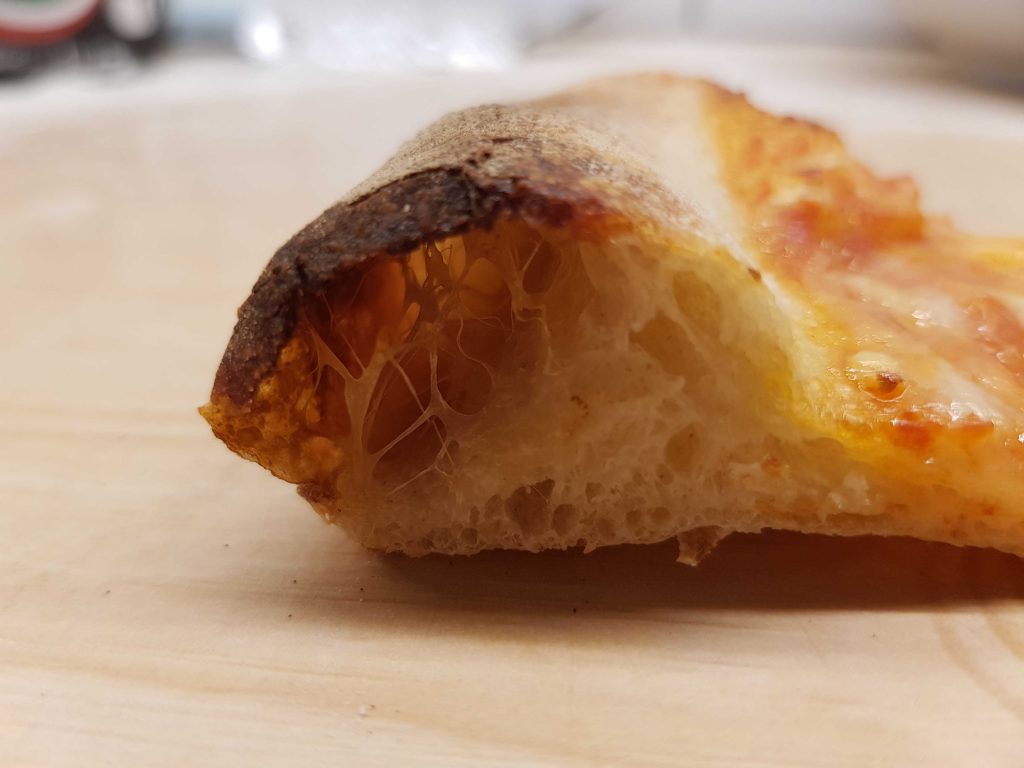
You can read my full review and comparison between Caputo Nuvola and Caputo Pizzeria here.
Related
- Ooni Turning Peel Review: The Best Peel for Home - April 15, 2024
- Gi.Metal Turning Peel Review: Is This the Ultimate Pizza Tool? - April 14, 2024
- Discover Pizza Mastunicola: The Story of the First Pizza - April 7, 2024
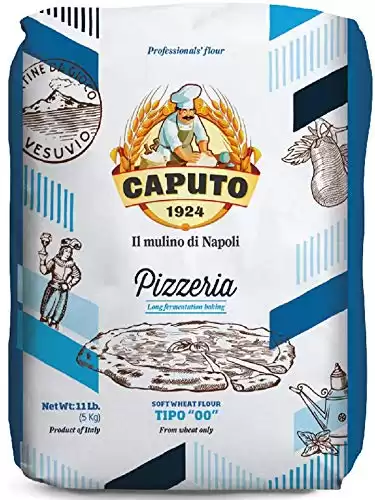
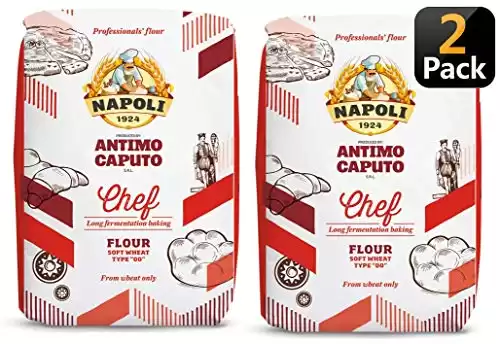


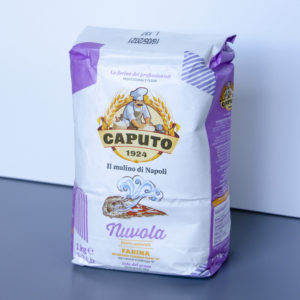
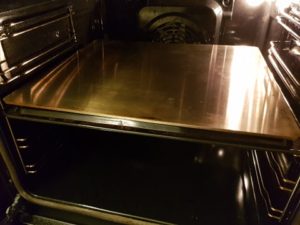

Thanks for all of the great information. Your website is amazing! Quick question, in the Authentic Neapolitan Pizza Dough article you mention the amount of yeast is not propositional with the other ingredients in the recipe. For example if you multiple the flour by 5 the yeast should only be multiplied by 3. But when I tried your pizza dough calculator, it seems like it multiples everything evenly. I’m trying to reduce the recipe you have listed by about 80% but I’m not quite sure how much yeast to use.
Hi! The dough calculator is a very early version and does unfortunately not account for this yet.
Calculating yeast accurately is pretty complicated, as it depends on the leaving time, temperature, humidity, dough hydration, salt content, etc. So it’s hard to estimate. The non-proportional amount of yeast is however more relevant for really large batches (5kg+ of flour).
I, therefore, recommend just scale the recipe and experiment from there. The recipe, based on the AVPN standard, is meant as a starting point, but you probably have to do minor adjustments depending on the factors affecting the yeast mentioned above.
You can also check out the mobile app called PizzApp+, with can be found both for Apple and Android phones. This includes yeast calculation based on fermentation time and temperatures. (I have found that I always need to add a little more yeast than the app says though, possibly because my house is relatively dry)
Good luck with your pizza baking! 🙂
How much yeast would you recommend using if I cut the AVPN recipe in half?
Thanks for the info! I really appreciate all of the details you provide. Are you on social media? I’d love to follow you.
I’m happy to hear that! I’m not on social media currently, perhaps in the future.
How much yeast would you recommend I start with if I wanted to cut the AVPN standard recipe in half?
Generally speaking, simply divide the amount of yeast in two, like the other ingredients.
Personally, I’ve had great success fermenting at room temperature (around 24°C/75°F) lately:
* 10 hours: 0.07% active dry yeast (0.6g if you divide the recipe in two)
* 20 hours: 0.03% active dry yeast (0.3g if you divide the recipe in two)
What is the perfect mixture for 00 pizza dough
It depends on what you’re looking for. According to the AVPN (The True Neapolitan Pizza Association) to make true Neapolitan pizza you need:
1000g Tipo 00 flour
600g water (60%)
30g salt (3%)
1g of fresh yeast (0.1%) or 0.3g of active dry yeast (0.03%)
I personally like to increase the hydration a bit, to 65-68% (650-680g of water instead of 600) to get a taller, softer rim. I especially recommend that if you’re baking pizza in a home oven and not a pizza oven. Since the longer baking time required at lower temperatures will dry out the crust more.
How much yeast would you recommend using if I cut the AVPN recipe in half?
I am trying to make Pepperoni balls like the ones from my home town. The dough gets stuffed with pepperoni and cheese and deep fried, I am thinking the airy dough would be better?
Thanks,
Margaret
Definitely give it a try! 🙂